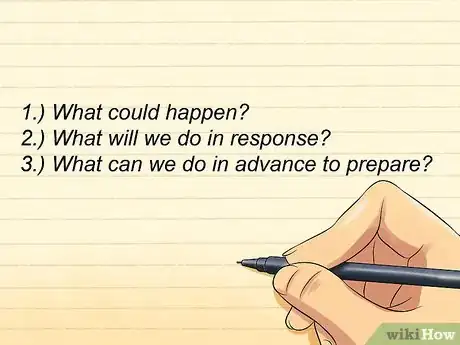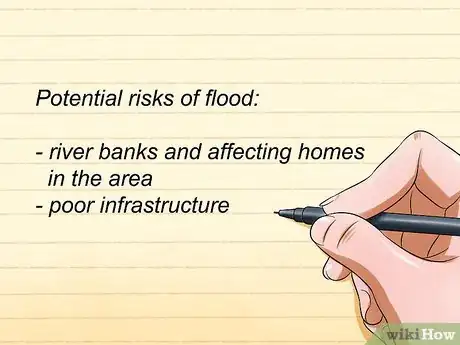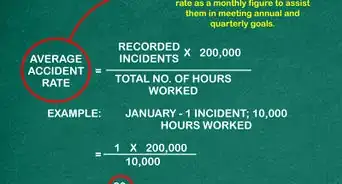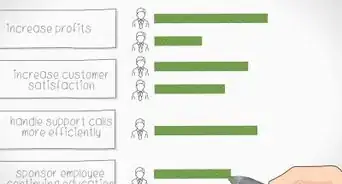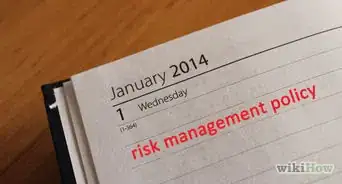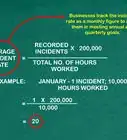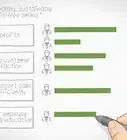wikiHow is a “wiki,” similar to Wikipedia, which means that many of our articles are co-written by multiple authors. To create this article, 17 people, some anonymous, worked to edit and improve it over time.
wikiHow marks an article as reader-approved once it receives enough positive feedback. This article received 16 testimonials and 88% of readers who voted found it helpful, earning it our reader-approved status.
This article has been viewed 559,635 times.
Learn more...
Organizations create contingency plans, sometimes called a "Plan B," to prepare for something bad that could affect the organization's ability to function. Developing an effective contingency plan is essential for any organization. Many things can put an organization at risk, from a technical disaster (like a data breach) to a natural one (like a flood). Writing contingency plans prepares an organization for such possibilities.
Steps
Sample Contingency Plans
Assessing the Risks
-
1Prepare to write your contingency plan. The key goal should be to make sure you can maintain the operation of your organization if the disaster were to occur.
- It’s a good idea to have a formal policy spelling out the need for a contingency plan.[1]
- The plan should be simple overall. The language and directions in it should be understandable to future audiences. You never know who will have to implement it.
- Figure out the specific trigger that will require you to use your contingency plan. Determine how you will measure success so that you can return to normal operations. Identify all operations that are critical to your business continuing.
-
2Make sure the plan answers the three key questions of contingency plans. Making sure your plan addresses each of these three questions will help you ensure you don't miss anything.
- What could happen?
- What will we do in response?
- What can we do in advance to prepare?
Advertisement -
3Figure out the risks that are most likely to occur for your specific organization. Determining potential risks is one of the most important aspects of a contingency plan. This won’t be a one-size-fits-all process. You need to determine the risks that are unique to the organization. There are many possible risks that businesses can face.
- Natural disasters, such as floods, hurricanes and droughts may require a contingency plan.[2] Other possible risks include a crisis, work site accident, personnel problems (like death of a leader or a strike), data loss, mismanagement, and product issues (like a recall).
- You should focus on areas including management, communications, financial resources, coordination, logistical and technical responses.
- Technical disasters can include those components of your organization dealing with communication infrastructure. You will want to consider potential loss of data or customers.[3]
-
4Prioritize the risks. Rank the risks based on the probability they will occur. All risks are not created equal, and most contingency plans can’t deal in depth with every single potential risk. You need to figure out which are most likely and would affect the company most.
- Focus in on the most critical events. You should list every single event that might affect operations, but then rank them 1 to 10. What would be the impact of each event? A small fire isolated to one machine will likely rank lower than the entire plant burning down, for example.
- Then, develop a ranking for how often the risk might occur. For example, you could score it a 10 if it could happen once a month and a 1 if it might happen once in 100 years. Then, multiply the two scores, for likelihood and impact, to get a total score.
- Work on the highest scores first. Come up with a cut off. You might look at the low score items and develop a general process, though. Areas that are essential to the organization’s survival are usually put at the top, such as maintaining cash flow, market share, and staff support.[4]
Identify scenarios
-
1Develop scenarios for the highest-ranked risks. You will need to produce realistic scenarios for each risk in order to develop an effective contingency plan. Specifically outline what could happen if each of the top priority risks was to occur.[5]
- You can start determining impacts after you develop the scenarios thoroughly. What could be the ultimate impact of each scenario, in detail?
- You could develop different gradations of the same scenario, such as the best-case, most likely case, and worst-case scenario.[6]
-
2Create a timeline for how the scenarios might unfold. Determine who will be in charge of what and when. Don’t forget to update contact lists and determine who will be responsible for notifications.
- Outline time frames. What will happen on the first day or the first week? Be very specific.
- You could have timelines for scenarios that deal with physical vulnerabilities, organizational vulnerabilities and institutional vulnerabilities. For example, physical vulnerability might deal with infrastructure. Organizational might deal with whether there are early warning systems or skilled response teams. Institutional vulnerabilities might deal with whether there are financial resources available or external partners. Different people might be in charge of different aspects.
-
3Decide what will be most essential to get your business operational again. Explore these angles in detail. Chart out capacities as well as vulnerabilities. What capacity does the organization have to meet risks or mitigate them?
- For example, say the potential hazard is a flood. A potential risk might be river floods overflowing the banks and affecting homes in the area. The vulnerability might be poor infrastructure. The capacity might be having skilled personnel on hand.
- Do an honest assessment of resources. What functions will you have to change or reduce because of limited resources? Perform a business impact analysis. You want to identify which areas are necessary for the business to meet its mission and continue operating.
-
4Find ways to reduce risk. It’s usually not enough to develop a “Plan B” and then sit back and hope it never comes to fruition. Assess how you can take steps immediately to reduce the risks. Develop preventative strategies.
- Consider the availability of partners. What local resources would be available if the disaster struck? Would neighbors be willing to help?
- The best contingency plans help companies pinpoint areas they can improve so that they reduce the likelihood of the plan being needed in the first place.
- You might realize you need insurance, for example, or should have disaster drills. Perhaps you realize that key personnel need additional training. When it comes to data threats, you could have a back-up system installed. Devise a plan for each scenario
Maintain your Contingency Plan
-
1Communicate about the plan to all employees. You need to educate key people in your organization about the place before it’s ever needed.
- Tell people which role and responsibilities they will have so there’s no confusion if the plan needs to be implemented in an emergency. This will reduce the chances of panic.
- Give people the proper training they will need to meet their obligations as outlined in the plan. Hold drills if needed. Make adjustments after observing training.
-
2Test your contingency plan. You can make testing manageable and cost-effective by testing in four stages. If an area proves to be flawed or conflicts with contingency plans from other departments, you can edit and the retest the plan.
- Conduct a senior staff review. The senior staff chooses a date and time to go over all contingency plans and recognize the people who thoroughly completed their assignment.
- Perform an interdepartmental review. This is where every department reviews another department's plans. This is the stage that allocates resources and identifies conflicts.
- Study failures of critical systems. This testing stage can be localized within departments. Testing involves the simulation of system and/or vendor failures. You can role play scenarios without having to actually shut down important equipment or processes.
- The real deal. Finally, you should fully test out the contingency plan. This can involve short-term shutdowns in key areas done in real time.
-
3Store the plan in a place where it can be easily accessed. If disaster strikes, you don’t want the plan to burn down with the fire or be swept away with the flood. You don’t want a data breach to make it hard to retrieve the plan when you need it most.
- Find a location for the plan (or a copy of it) in a different location. You want to keep it somewhere, though, where you can get to it fast if you need to.
- Always keep a copy of the plan in a different location from the original. And make sure that more than one person knows how to access it and has authority to do so.
-
4Revisit the plan on a regular schedule. Sometimes things change. Your assumptions could be outdated. The risks might be greater than they were before.
- Involve more than one person in the plan and its updates. For example, you might want a new employee to look at it with a fresh eye or have it audited.
- Confirm all assumptions by matching them with recent data or by checking them with a third-party. Perhaps the back-up computer system holds less data than you assumed.
Community Q&A
-
QuestionHow you will know when to invoke the contingency plan?
 Community AnswerYour contingency plan should have a trigger for each scenario deemed critical. This trigger includes what conditions must be met for the plan to activate and at what specified time (if possible), to allow all users of the plan to be as synchronized as possible from the offset.
Community AnswerYour contingency plan should have a trigger for each scenario deemed critical. This trigger includes what conditions must be met for the plan to activate and at what specified time (if possible), to allow all users of the plan to be as synchronized as possible from the offset. -
QuestionHow do I make a contingency plan for a paint facility?
 Community AnswerContingency plans are designed taking into account the same aspects for each type of business, what varies are the critical business continuity key points. But as far as events that have impact in business, they are mostly the the same: hacking, natural causes, etc. The main goal is to identify key actions and determine redundant actions to keep it running.
Community AnswerContingency plans are designed taking into account the same aspects for each type of business, what varies are the critical business continuity key points. But as far as events that have impact in business, they are mostly the the same: hacking, natural causes, etc. The main goal is to identify key actions and determine redundant actions to keep it running. -
QuestionHow do I make a contingency plan for when my equipment breaks down at work?
 Community AnswerFind the root cause of the breakdown. Evaluate the recovery time. If the repair and recovery time is too long and affects the delivery of the product, try to get back-up equipment, either from the other production lines or as a new purchase. Communicate with customers about the issue, impact, and solution.
Community AnswerFind the root cause of the breakdown. Evaluate the recovery time. If the repair and recovery time is too long and affects the delivery of the product, try to get back-up equipment, either from the other production lines or as a new purchase. Communicate with customers about the issue, impact, and solution.
References
- ↑ http://whatis.techtarget.com/definition/contingency-plan
- ↑ https://www.ifrc.org/PageFiles/40825/1220900-CPG%202012-EN-LR.pdf
- ↑ http://sbinfocanada.about.com/od/businessplanning/a/Business-Contingency-Plan.htm
- ↑ https://www.mindtools.com/pages/article/newLDR_51.htm
- ↑ http://planningskills.com/askdan/6.php
- ↑ http://study.com/academy/lesson/what-is-contingency-planning-in-business-definition-example-importance.html
About This Article
To write a contingency plan, start by assessing the potential risks for your organization. Focus on risks associated with management, communications, financial resources, coordination, and technology, but you can also include natural disasters, accidents, and personnel problems. Develop realistic scenarios for the highest ranking risks, then include your intended strategies for getting the business operational again. For tips on maintaining and testing your contingency plan, read on!




